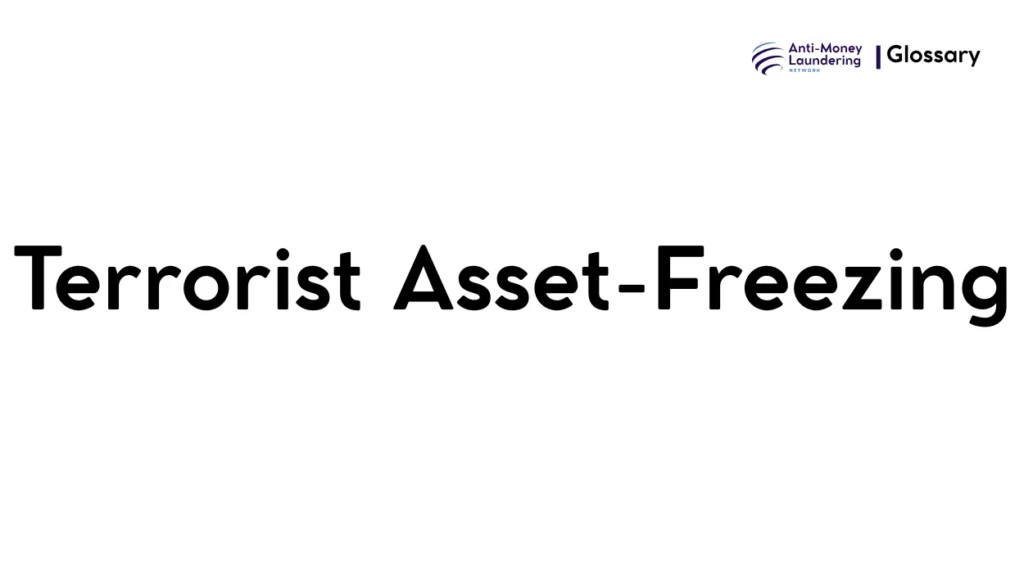Definition
Terrorist Asset-Freezing is an Anti-Money Laundering (AML) measure that involves the immediate and mandatory freezing of funds and assets belonging to individuals, entities, or groups suspected or designated as involved in terrorist activities. This prevents these persons from accessing, using, or directing these resources directly or indirectly to fund terrorist operations or activities. Unlike traditional money laundering controls focusing on the origin of illicit funds, terrorist asset-freezing targets the disruption of terrorist financing regardless of the funds’ source.
Purpose and Regulatory Basis
The primary role of terrorist asset-freezing within AML frameworks is to combat the financing of terrorism (CFT) by denying terrorists or their facilitators access to financial resources. It is crucial because terrorist financing can involve both lawful and unlawful funds, making standard money-laundering detection insufficient.
This measure complements AML activities and is mandated by global and national regulations, including:
- Financial Action Task Force (FATF) recommendations requiring countries to implement targeted financial sanctions to freeze terrorist-related assets without delay.
- USA PATRIOT Act provisions empowering U.S. authorities to identify and freeze terrorist-linked assets.
- European Union Anti-Money Laundering Directives (AMLD) which integrate UN Security Council sanctions into EU law for freezing terrorist-related assets.
These regulations are often aligned with United Nations Security Council Resolutions (e.g., UNSCR 1267 and 1373) that require member states to freeze assets linked to designated terrorist groups and individuals.
When and How It Applies
Terrorist asset-freezing is applied when a financial institution or regulatory authority is notified or suspects that certain assets belong to or benefit terrorists or terrorist organizations. Triggers include:
- Listings by national governments or international bodies such as the UN sanctions committees.
- Reasonable belief or suspicion that an individual or entity engages in terrorist activities.
- Regulatory or court orders mandating asset freeze.
Examples include:
- Freezing accounts of persons designated on UN sanctions lists.
- Blocking transactions linked to suspected financing of terrorism.
- Preventing access to assets of groups like Al-Qaida or Taliban under prescribed regulations.
Types or Variants
There are multiple forms of terrorist asset-freezing depending on jurisdiction and scope:
- UN-mandated Freezes: Binding for member states to freeze assets of individuals/entities on UN sanctions lists.
- National Executive Orders: Such as those under the USA PATRIOT Act or UK’s Terrorist Asset-Freezing regimes, which can designate targets independently for freezing.
- Emergency Temporary Freezing: Used to freeze assets quickly on suspicion pending investigation.
Each may differ in procedural requirements and duration but share the core purpose of blocking terrorist financing resources.
Procedures and Implementation
Financial institutions and obligated entities must implement rigorous controls including:
- Screening Customers and Transactions: Against updated sanctions and terrorist lists.
- Immediate Asset Freeze: Upon identification of matches or regulatory notice.
- Record-Keeping: Detailed documentation of frozen assets and interactions.
- Notification: Informing relevant authorities promptly.
- Ongoing Monitoring: To detect attempts to circumvent freezes.
- Internal Controls: Policies and training to ensure staff awareness and compliance.
Technology systems often automate screening against sanctions databases to improve accuracy and timeliness.
Impact on Customers/Clients
From a customer perspective, asset-freezing can result in:
- Inability to access or transact with frozen funds or properties.
- Restrictions on receiving payments or transferring assets.
- Potential reputational damage pending resolution.
Customers have limited rights to use or move frozen resources unless authorized under specific licenses or regulatory relief. They may contest listings or freezes through legal or administrative channels depending on jurisdiction.
Duration, Review, and Resolution
Asset freezes are typically indefinite until:
- An individual or entity is removed from sanctions or terrorist lists.
- Judicial or administrative review determines improper designation.
- A regulatory authority or UN Security Council lifts the freeze.
Financial institutions must periodically review frozen assets, maintain compliance records, and implement updates as lists or regulations change.
Reporting and Compliance Duties
Institutions are required to:
- Report frozen assets and suspicious activities to Financial Intelligence Units (FIUs).
- Maintain auditable records demonstrating compliance.
- Cooperate with law enforcement and regulatory investigations.
- Implement sanctions screening aligned with evolving regulatory mandates.
Failure to comply can result in significant penalties, including fines and criminal charges.
Related AML Terms
Terrorist asset-freezing relates closely to:
- Terrorist Financing: Provision of funds to terrorists that is targeted by freezing.
- Sanctions Compliance: Obligations to adhere to international and national sanctions laws.
- Suspicious Activity Reporting (SAR): Reporting unusual transactions potentially linked to terrorism.
- Know Your Customer (KYC): Procedures to identify and verify clients as foundational to freeze implementation.
Challenges and Best Practices
Common challenges include:
- Identification Accuracy: Avoiding false positives and ensuring exact matches for freezing.
- Legal and Human Rights Concerns: Balancing security with due process and rights of individuals.
- Rapid Updating of Lists: Keeping systems current with frequent changes in sanctions lists.
Best practices involve:
- Robust automated screening with human oversight.
- Clear procedures for handling potential matches.
- Regular staff training and audits.
- Transparent resolution processes and appeal mechanisms for customers.
Recent Developments
Advancements impacting terrorist asset-freezing include:
- AI and Big Data: Enhanced analytics to detect subtle links to terrorism financing.
- Increased International Collaboration: Sharing of sanctions lists and intelligence among jurisdictions.
- Regulatory Updates: Expansion of designations to cover emerging terrorist threats and new financing methods.
Compliance technology now integrates cross-sector data sources to improve detection and responsiveness.
Terrorist asset-freezing is a cornerstone AML/CFT tool designed to prevent terrorists from accessing financial resources by freezing their assets immediately and comprehensively. Supported by global regulations and enforcement mechanisms, it requires diligent implementation by financial institutions through robust screening, reporting, and compliance procedures. Despite operational challenges, effective terrorist asset-freezing significantly helps disrupt terrorist financing, supporting broader financial system integrity and security.

